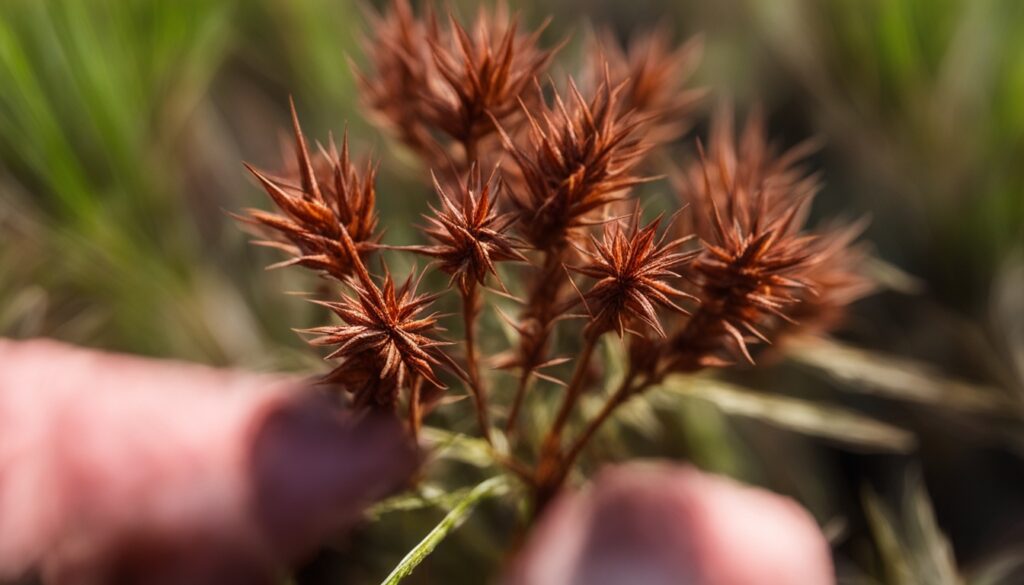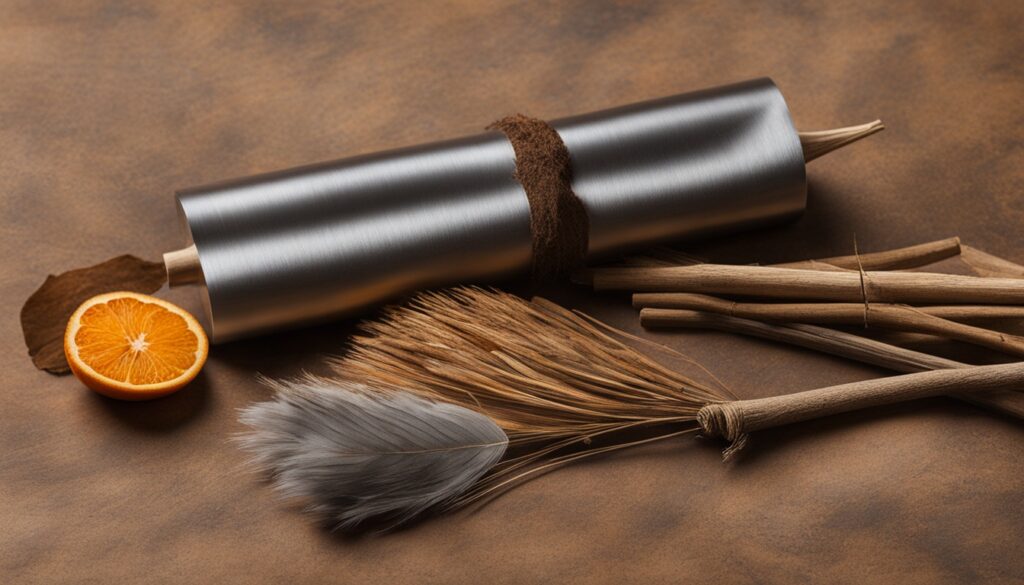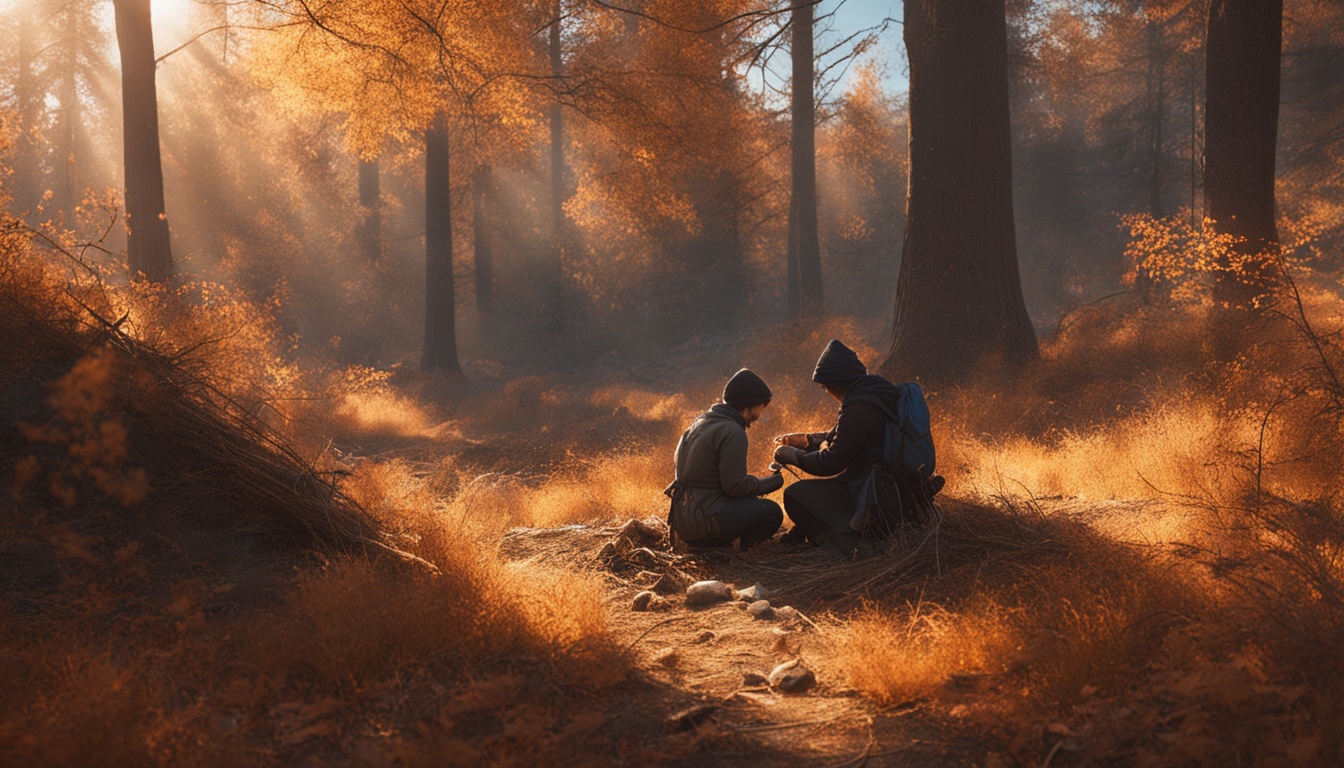In the wild, knowing how to start a fire is very important. It can keep you warm or even save your life. Learning to find and use natural tinder is key for outdoor lovers. It helps campers and bushcraft experts start fires easily.
Key Takeaways
- Tinder is essential for starting fires in the wilderness
- Natural tinder can be found in various plant-based materials
- Dry and fluffy materials make the best tinder
- Common sources of natural tinder include grasses, leaves, and pine needles
- Bark can also be used as a reliable tinder source
What is Natural Tinder?
Starting a fire outside needs tinder. It’s dead, dry stuff that lights up easily. For natural tinder to work well, it must have certain traits.
Plant-Based Materials
Natural tinder comes from plants. Think of dried grasses, leaves, and pine needles. These are great for starting fires because they’re easy to find and light up fast.
Dry and Fluffy
Good natural tinder is also dry. Wet tinder won’t light. The best tinder is dry, fluffy, and has lots of surface area. This makes it easier to catch a spark.
“The key to successful fire starting with natural tinder is finding materials that are completely dry and have a lot of surface area to catch a spark.”
Common Sources of Natural Tinder
Finding natural tinder in the wild is easy with many options. Grasses, leaves, and pine needles are great for starting fires. They help get your campfire going.
Grasses
Many grass types are great for tinder. Look for tan or brown blades that are dry and dead. These are easy to light and help start your fire fast.
Leaves
Dead leaves from trees and plants are perfect for tinder. They light up easily and keep the fire going. Choose leaves that are tan, brown, or dry.
Pine Needles
Dead pine needles are also great for tinder. They catch fire quickly and help start your fire. Use needles that have fallen to the ground away from the tree.
Using these natural tinder sources can help you start a fire in the wild. Grasses, leaves, and pine needles are all good choices. They make starting your campfire easy.
Bark as Tinder
Looking for natural tinder in the wild? Tree and plant bark is a great choice. Dry inner bark from dead trees and plants makes excellent tinder. You can use the dead inner bark from trees like tulip poplar, cedar, juniper, and mulberry. It’s easy to light and works well with a spark.
Outer bark from some trees is also good tinder. Cedar, juniper, and paper birch trees have bark that shreds into fine tinder. This makes starting a fire easier.
To get inner bark tinder, find dead, dry branches or logs. Peel off the outer layer to reveal the inner bark. Then, shred it into a fluffy texture that lights easily. For outer bark tinder, strip away the outer layers of certain trees. Break the bark into thin strands that are perfect for starting a fire.
| Tinder Source | Recommended Tree/Plant Types |
|---|---|
| Inner Bark Tinder | Tulip poplar, cedar, juniper, mulberry, some oaks |
| Outer Bark Tinder | Cedar, juniper, paper birch |
Knowing which types of bark make good tinder helps you start fires in the wild. You can use a ferro rod, a magnifying glass, or other methods to get a fire going.
Finding natural tinder
Looking for natural tinder in the wild is easy. You can find many things that help start a fire quickly. Dead plant tops, fluffy seed down, and fine wood shavings are all great options.
Weed Tops and Seed Down
Many plants have dry tops that make great tinder. Goldenrod flower heads are perfect for starting fires. Also, seed down from thistle, cattail, and milkweed catches fire easily.
Even the seed down from cottonwoods can be used as tinder.
Wood Shavings
Wood shavings are another good tinder choice. You can get them by scraping dead, dry wood with a knife or stone. These shavings light up fast with a little spark.
Learning about these tinder sources and how to collect them will help you start fires in the wild.

Avoiding Toxic Tinders
When you’re looking for tinder to start a fire, be careful. Some plants can be harmful if you don’t know what they are. Let’s talk about the bad tinders to avoid and how to stay safe.
The inner bark of the black locust tree is one to watch out for. It might look good for starting a fire, but it can give you a bad headache. Also, the fuzzy fibers on old poison ivy vines might look like good tinder, but they can make you break out in a rash if you touch them.
Burning poison ivy, poison sumac, or poison oak is very dangerous. The smoke can make you breathe hard and can get on your skin and clothes. This can cause serious problems like trouble breathing or a rash all over your body that lasts for a long time.
So, it’s important to know which plants are harmful and stay away from them. When you’re looking for tinder, be careful and don’t take risks. Use safe things like dry grass, leaves, and wood shavings to start your fire.
Your safety is the most important thing when you’re in the wild. By knowing which toxic tinders to avoid, you can have a safe and fun time outside.
Making a Tinder Bundle
Making a good tinder bundle is key to starting a fire with a magnifying glass. The way you put it together is very important. It helps catch an ember and keep the flame going. Let’s look at the three main parts of a good tinder bundle.
Outer Layer
The outside of the tinder bundle should have dry, easy-to-light materials. Good choices are red pine needles, dry grass, or small, flammable plants. These help the fire start and spread fast once it catches.
Middle Layer
Between the outside and inside, there’s a middle layer. It should have materials that light up easily but burn slowly. Cotton balls, dandelion fluff, or dry moss are great here. They catch embers well and help the flame grow strong.
Inner Layer
The inside of the tinder bundle is for the easiest-to-light materials. Punk wood, charcloth, or other soft, dry tinder are perfect. This layer makes sure the fire keeps burning after it starts.

With these three layers, you can make a great tinder bundle. It works well with a magnifying glass. The right tinder bundle structure and tinder bundle layers mean you can start a fire easily outdoors.
Starting a Fire with a Magnifying Glass
Learning to start a fire with a magnifying glass is a cool skill for wilderness survival. It shows how the sun’s rays can be powerful. It also teaches us about the different materials we can use to start fire with magnifying glass.
To make a fire with a magnifying lens, gather some tinder. Put dry grass or wood shavings on the outside. In the middle, use cotton or sawdust to help the ember grow.
At the center, put soft, dry stuff like punk wood or charcloth. This will hold the ember and light up.
- Focus the magnifying glass on the tinder’s inner layer. Aim the sun’s rays at one spot.
- Wait for it to start smoldering. Then, blow gently to make it into a small flame.
- After the tinder is burning, add bigger pieces of natural tinder for magnifying glass. Use twigs and dry leaves to grow the fire.
With practice and the right materials, you can easily use magnifying lens to start fire outside. This skill makes you feel proud and gives you a way to make heat and light when you need it.
“The sun’s rays, when focused through a magnifying glass, can be a powerful tool in the wilderness. With the right tinder and a bit of patience, you can harness the power of the sun to start a fire from scratch.”
Conclusion
Learning how to find and use natural tinders is key to surviving in the wild. You can start fires outside with simple tools like a magnifying glass. This skill keeps you safe and warm when you’re in the wild.
This guide taught you how to pick the right grasses, leaves, and pine needles for tinder. It also showed you how to make a good tinder bundle. With practice, you’ll be great at starting fires. This skill helps you stay warm, signal for help, and cook food.
If you love hiking, camping, or just being outside, learning about natural tinders is a must. It makes you better at surviving in the wild. Use these skills to enjoy nature safely. Start your next adventure knowing you can make a fire when you need to.
FAQ
What is natural tinder?
What are some common sources of natural tinder?
What types of bark make good tinder?
What types of natural tinders should be avoided?
How do you make a tinder bundle for fire starting with a magnifying glass?
How do you start a fire with a magnifying glass?
Source Links
- Survival Skills: Finding 6 Great Tinder Sources in the Wild – https://www.outdoorlife.com/blogs/survivalist/2011/11/survival-skills-finding-tinder-part-one-tinder-wild/
- Which natural tinder is best for starting a fire – https://www.schoolofthewild.com/blog/which-natural-tinder-is-best-for-starting-a-fire
- Start a Fire With a Magnifying Glass Using Natural Tinder – https://survivalskills.guide/start-fire-magnifying-glass-using-natural-tinder/
